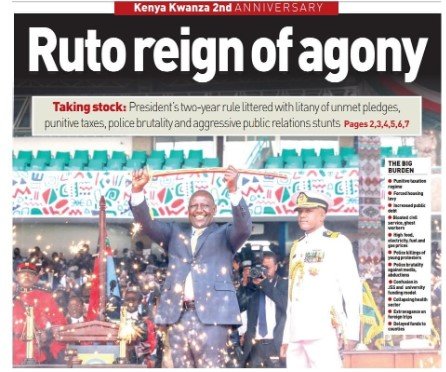A dramatic victory marred by soaring record of crises

Two years ago, on this very day, then Deputy President William Ruto defied the odds and ascended to Kenya’s highest office, capping what many view as a remarkable political fairytale. From humble beginnings as a chicken seller to becoming the country’s fifth President, Ruto’s journey to power was as dramatic as it was improbable.
His victory against Raila Odinga – and despite the backing of the veteran opposition leader by the administration of the time – marked a defining moment in Kenyan politics.
After successfully ducking the fearsome political cannons hurled his way while simultaneously hopping past multiple traps supposedly set up by the so-called deep state, Ruto’s first significant test came before he had even settled into office.
Raila contested the 2022 election results, leading to a tense Supreme Court battle. The court proceedings raised critical questions about the integrity of the election technology, the transmission of results, and the accuracy of vote counts. In the end, the court upheld Ruto’s victory, a decision that would only fan the flames of opposition protests in the months that followed.
On September 13, 2022, Ruto was sworn in amid a grand ceremony at Kasarani Stadium, attended by global dignitaries and thousands of jubilant supporters. Yet, the road ahead was far from smooth. It would be a bumpy ride full of glitches. The Kenya Kwanza administration has faced formidable challenges, raising questions about the President’s ability to fulfill the promises of his campaign.
Tax hikes
Thousands of protesters heeding calls from Raila for demos against the government over tax hikes took to the streets, which led to violence. The usually stubborn protesters from Raila’s strongholds like the Kibera and Mathare slums in Nairobi, as well as in Kisumu and parts of Mombasa, battled the police in repeated clashes with riot police.
Demonstrations significantly increased in Kenya in 2023, primarily driven by Raila mobilising his supporters against the Kenya Kwanza government, according to the Armed Conflict Location and Event Data (ACLED), an independent, international non-profit organisation that collects and analyses data on political violence and protest events across the globe.
From January 1 to September 15, 2023, ACLED recorded over 840 demonstration events across Kenya; 26 percent of the protests drew intervention from security forces – compared with only 15 percent of such events in 2022. Police forces intervened in around half of the demonstrations organised by the Azimio coalition in 2023. Police intervention also become more lethal, resulting in at least 35 deaths – all during Azimio-led demonstrations.
“In July alone, the Azimio coalition organised over 150 demonstration events across the country to protest against the passing of a Finance Bill enacting contested tax hikes,” ACLED report.
“While the protests in March and May were limited to areas perceived to be the opposition’s stronghold, such as the capital city of Nairobi, the coastal city of Mombasa, and other parts of western Kenya, the July protests extended beyond the political divide and spread to counties such as Laikipia, Meru, Nyeri, and Muranga, all of which are considered strongholds of the President’s coalition,” said an ACLED report titled ‘Kenya: Police Use Excessive Force in Response to Anti-Government Demonstrations’.
“The protests, according to Raila, were a matter for all Kenyans rather than a party-based issue. But in the North Rift region – and President Ruto’s home region – Azimio supporters and their leaders stayed away from the protests, alleging threats and intimidation from police and Kenya Kwanza supporters.”
Most of the protests have been around the high cost of living. The recent Gen Z-led anti-tax protests were, however, Ruto’s toughest test.
In a notable shift from typical protests, the demos by Gen Z and Millennials were distinctively organised, inclusive, and resilient. The young, dynamic university and college students showcased an extraordinary level of determination.
The protests caught the government almost off guard; the youth relied on modern technology, such as livestreaming and social media, to educate and mobilise participants. Dubbed ‘Occupy Everywhere, Reject Finance Bill,’ the protests would meticulously be orchestrated via social media platforms, including WhatsApp groups, X Spaces, and TikTok.
In the early stages of the protests, thousands of Kenyans used Zello, an app that mimics a walkie-talkie, to coordinate movements and communicate anonymously, leaving police clueless. Government officials did not see it coming as the protesters went on to “occupy” Parliament in the most daring move by citizens in Kenya’s history.
Deadly chaos
This would degenerate into deadly chaos that saw over 40 people killed and an unknown number missing.
At the height of the crisis, the under-fire President Ruto would be forced to withdraw the unpopular finance bill and later dismiss with “immediate effect” all his ministers and the Attorney General.
The President said the move came after “reflection, listening to Kenyans and after a holistic appraisal of my Cabinet”.
Besides the protests, he also had to deal with a weakening Kenyan shilling. Shortly after the 2022 elections, the shilling depreciated rapidly against the US dollar, fuelling a wave of political discontent. President Ruto said the shilling weakened significantly against the greenback because the United States had consistently raised its Federal Reserve interest rates over several months.
In an interview with Kenyan journalists at State House in Nairobi, Ruto said the previous administration “artificially” suppressed the value of the dollar against the Kenyan shilling. The US dollar was exchanging at 153.99 shillings as of Friday, December 15, 2023, knocking off nearly 24 percent of the Kenyan currency’s value in under a year.
Amid protests and economic turbulence, the administration has also been confronted by other significant challenges. One is the banditry crisis in the North Rift region, which prompted the government to deploy Kenya Defense Forces personnel to work with the National Police Service in a bid to restore order.
The government has also had to contend with corruption scandals, notably involving substandard fertiliser, which threatened to undermine one of Ruto’s flagship pledges: reducing food prices by subsidising production inputs.
Helicopter crash
Further complicating matters, the health sector was thrown into disarray when a nationwide strike by medical interns paralysed services for 56 days. The protracted standoff underscored the administration’s struggles to address systemic issues in essential public services.
Adding to the President’s burdens, tragedy struck in April 2024, when Chief of Defense Forces General Francis Ogolla died in a helicopter crash alongside several other military personnel. The loss of Ogolla, a key figure in Kenya’s defense apparatus, was a devastating blow for Ruto and the nation.
Perhaps the most harrowing challenge for Ruto’s administration was the Shakahola massacre, which resulted from preacher Paul Mackenzie leading hundreds of followers to their deaths through extreme fasting. The discovery of mass graves in the Shakahola forest in Kilifi county, with more than 428 bodies exhumed to date, has cast a dark shadow over the country. Critics argue that the tragedy could have been averted had the government acted sooner on warnings about Mackenzie’s radical teachings.
President Ruto’s administration has also faced several legal setbacks, with key decisions being overturned by courts. These included the appointment of 50 Chief Administrative Secretaries, the IEBC selection panel, and the controversial housing levy proposal.
Two years into his presidency, it is clear that the journey has been anything but smooth. While Ruto’s rise to power was a testament to his resilience and political savvy, the numerous crises he has faced since taking office have tested his leadership in unprecedented ways. Whether he can steady the ship and deliver on his promises remains to be seen, but one thing is certain – the next three years will be critical in determining the legacy of Ruto’s presidency.









